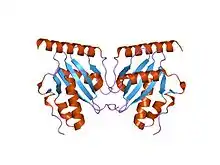ParDE type II toxin-antitoxin system
The parDE type II toxin-antitoxin system is one example of the bacterial toxin-antitoxin (TA) systems that encode two proteins, one a potent inhibitor of cell proliferation (toxin) and the other its specific antidote (antitoxin). These systems preferentially guarantee growth of plasmid-carrying daughter cells in a bacterial population by killing newborn bacteria that have not inherited a plasmid copy at cell division (post-segregational killing).[1]
| ParE toxin of type II Toxin-anittoxin system | |||||||||
|---|---|---|---|---|---|---|---|---|---|
 crystal structure of archaeal rele-relb complex from pyrococcus horikoshii ot3 | |||||||||
| Identifiers | |||||||||
| Symbol | ParE_toxin | ||||||||
| Pfam | PF05016 | ||||||||
| Pfam clan | CL0136 | ||||||||
| InterPro | IPR007712 | ||||||||
| |||||||||
| ParD | |||||||||
|---|---|---|---|---|---|---|---|---|---|
| Identifiers | |||||||||
| Symbol | ParD | ||||||||
| Pfam | PF09386 | ||||||||
| Pfam clan | CL0057 | ||||||||
| InterPro | IPR018985 | ||||||||
| |||||||||
ParD is a plasmid anti-toxin that forms a ribbon-helix-helix DNA binding structure.[2] It stabilises plasmids by inhibiting ParE toxicity in cells that express ParD and ParE. ParD forms a dimer and also regulates its own promoter (parDE). As with CcdB the toxin target is DNA gyrase.[3] Induction of ParE toxin results in inhibition of cell division but not cell growth.
The parD and ccD systems are found to be strikingly similar in terms of their structures and actions. The antitoxin protein of each system interacts with its cognate toxin to neutralise the activity of the toxin and in the process the complex of the two becomes an efficient transcription repressor.[4]
External links
References
- Jensen RB, Gerdes K (1995). "Programmed cell death in bacteria: proteic plasmid stabilization systems". Mol Microbiol. 17 (2): 205–10. doi:10.1111/j.1365-2958.1995.mmi_17020205.x. PMID 7494469.
- Oberer M, Zangger K, Prytulla S, Keller W (January 2002). "The anti-toxin ParD of plasmid RK2 consists of two structurally distinct moieties and belongs to the ribbon-helix-helix family of DNA-binding proteins". Biochem. J. 361 (Pt 1): 41–7. doi:10.1042/0264-6021:3610041. PMC 1222296. PMID 11743881.
- Fiebig A, Castro Rojas CM, Siegal-Gaskins D, Crosson S (2010). "Interaction specificity, toxicity and regulation of a paralogous set of ParE/RelE-family toxin-antitoxin systems". Mol Microbiol. 77 (1): 236–51. doi:10.1111/j.1365-2958.2010.07207.x. PMC 2907451. PMID 20487277.
- Smith AB, López-Villarejo J, Diago-Navarro E, Mitchenall LA, Barendregt A, Heck AJ, et al. (2012). "A Common Origin for the Bacterial Toxin-Antitoxin Systems parD and ccd, Suggested by Analyses of Toxin/Target and Toxin/Antitoxin Interactions". PLOS ONE. 7 (9): e46499. doi:10.1371/journal.pone.0046499. PMC 3460896. PMID 23029540.